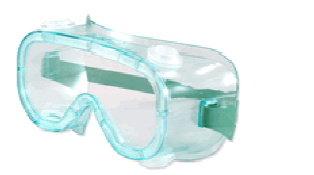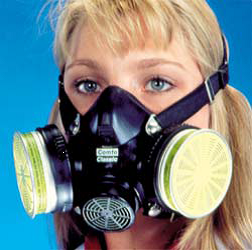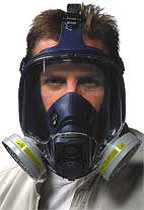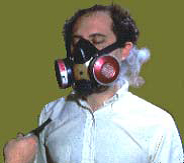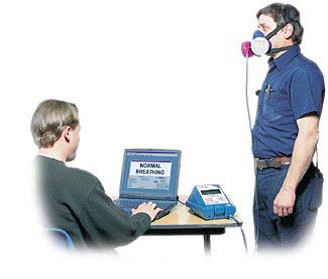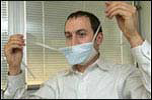Protective Equipment (PPE) includes safety glasses, goggles, face shields, gloves, lab coats, aprons, ear plugs, and respirators. Personal protective equipment is carefully selected to ensure that it is compatible with the chemicals and the process used.
Eye Protection
- Safety glasses or chemical goggles must be donned before entering any wet bench lab, including cell culture labs. This applies to lab visitors, GT maintenance and custodial workers as well as staff and students.
- Safety glasses must meet the ANSI Z87.1 - 2010 standard for impact resistance and have side shields for splash protection.
-

-
- Chemical goggles may be required for certain processes where safety glasses are deemed inadequate.
- Safety glasses or goggles must be worn over prescription glasses. Safety glasses worn over prescription glasses must be of a type intended for this purpose (Often referred to as Over the Glass Safety Glasses). Regular prescription glasses will not provide adequate protection in this case.
- Prescription safety glasses are acceptable as long as they have side shields for splash protection. (Check with your department to see if they fund such purchases.) Side shields must also meet the Z87.1 standard for impact resistance and be non-vented.
- Safety glasses or goggles are required all labs where soldering or machining/grinding occurs.
Lab Coats
- Shall be donned before handling chemicals, biologicals, or unsealed radiological sources.
- Shall cover the wearer to the knees
- Lab Coat fabric of poly-cotton blends are acceptable. Exceptions include:
- Labs were open flames are used (such as alcohol burners)- lab coat must be made of 100% cotton or flame resistant material.
- Labs where pyrophoric materials are handled- lab coat must be of flame resistant materials.
- Contact EHS (404-894-4635) for information about lab coat supply/laundry service.
For more information see the GT Laboratory and Personal Protective Equipment Policy.
Face Protection
- Face shields worn over safety glasses may be required for certain processes as determined by the Principle Investigator (PI) and/or GT EHS.
- Face shields must always be worn over safety glasses or goggles, not instead of safety glasses or goggles
- Processes involving high pressure reactors (>30 PSI) or pneumatic lines (>30 PSI), high pressure air lines, machining operations, and some cryogenic procedures require the use of face shields over safety glasses.
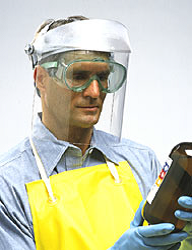
Hand Protection
Chemically Resistant Gloves
Gloves, especially, should be chosen carefully: They must be resistant to the chemicals being used but also not put the wearer at risk because of loss of dexterity, risk of ergonomic injury (such as increased muscle strain from gloves that are too heavy or stiff for pipetting, handling small objects, etc.), or increased risk of being caught in rotating equipment from gloves that are too loose on the user’s hands.
While there is no single glove material that provides 100% protection from all chemicals, a good all purpose glove is the nitrile exam glove. Latex gloves, which have been the most commonly used glove in labs for many years, are not resistant to many of the most common solvents found in laboratories. Additionally, latex is a natural product and is also a powerful allergen which readily becomes airborne on glove powder each time a glove is removed. Most hospitals have banned the use of powdered latex gloves. Many institutions have banned latex gloves entirely.
Consult the Safety Data Sheet section on handing instructions before selecting gloves. Some, but not all SDSs contain glove selection information. If you have questions about appropriate glove selection, contact EHS (404-894-4635). Be sure to include the name of the chemical and CAS number.
General Rules Regarding Chemically Resistant Glove Use
- Nitrile exam gloves are the general purpose glove of choice in all Georgia Tech wet bench labs.
- Cell culture labs, labs that deal with only biological samples or live animals, and labs where the purpose of glove use is to protect the product or the lab from human skin oils, may use powder free-latex gloves.
- Select gloves which are appropriate for the chemical(s) being used and also the process
- Before use, check gloves (even new ones) for physical damage such as tears or pin holes and for previous chemical damage: this is especially important when dealing with dangerous materials such as HF (Hydrofluoric Acid).
- When working, it may be advisable to wash the external surface of the gloves frequently with water.
- Most chemically resistant gloves, especially lightweight disposables, are combustible: keep hands well away from unprotected flames or other high temperature heat sources.
- When removing gloves, do so in a way that avoids the contaminated exterior contacting the skin (see diagram)
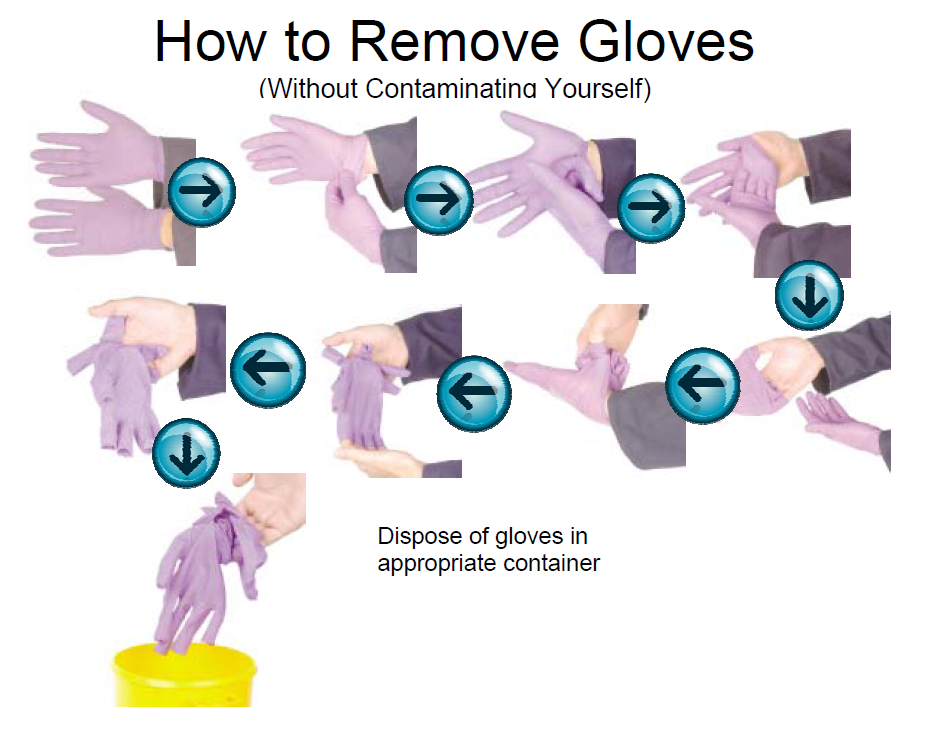
- Wash hands after removing gloves.
- Dispose of contaminated gloves properly.
- Do not attempt to re-use disposable gloves.
- Never wear possibly contaminated gloves outside of the laboratory or to handle telephones, computer keyboards, etc.
Gloves for Protection against Heat or Cold
Thermal gloves for cryogenic applications are commercially available in a variety of lengths to be appropriate for the application. One should remember, however, that no cryo-protective glove is intended to provide protection against direct immersion in cryogenic liquids. Cryo-protective aprons are also available.
A number of glove styles are commercially available for hot work processes, most of them involving layers of leather, Kevlar, and insulating foam. Like any other piece of personal protective equipment, thermally protective gloves must be chosen based on appropriate length, level of protection required, and also the level of dexterity required to accomplish the task at hand. Gloves made of asbestos cloth are not allowed in Georgia Tech laboratories. If you find asbestos containing gloves or hot pads in your lab, please contact EHS (404-894-4635) to remove and dispose of them appropriately.
Respiratory Protection
Respirators are a last resort when it comes to protecting people in the workplace. Under the Georgia Tech Respiratory protection program and the Federal Respiratory Protection Standard (29 CFR 1910. 134) employers are required to determine that no other method of protecting the employee is feasible before resorting to the use of respirators.
What is a respirator?
A respirator is a device designed to protect the wearer from inhalation of harmful substances. When chosen correctly and used properly, respirators can protect the wearer from harmful gases, mists, vapors, fumes, and fine particulates. Respirators fall into the following two general classifications, according to mode of operation:
- atmosphere-supplying respirators
- supplied air (SA) or air line respirator
-
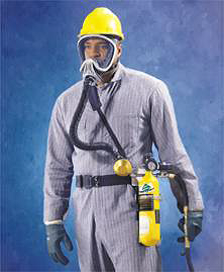
-
- self contained breathing apparatus (SCBA)
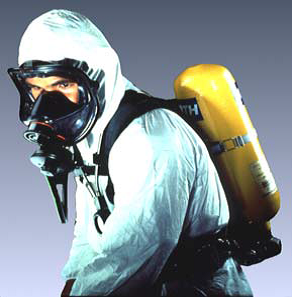
- supplied air (SA) or air line respirator
- air-purifying respirators
- N-95 filtering face piece respirator
- Half face air purifying respirator (HF APR) with an elastomeric face piece
- Full face air purifying respirator (FF APR) with an elastomeric face piece
- N-95 filtering face piece respirator
Using a respirator safely involves a lot more than just buying the respirator and strapping it on. Proper use of a respirator involves:
Step 1.
A Respiratory Hazard Evaluation to identify the hazard and determine whether it can be adequately controlled with engineering or administrative controls- without resorting to respirator use.
- Done by EHS
- Chemical users should request this when there is a question about the effectiveness of engineering controls or when engineering controls are not possible (Such as for some outdoor processes)
- Users can request Respiratory Hazard Evaluation by contacting EHS (404-894-4635)
Step 2.
Medical Clearance to wear a respirator (having a medical professional determine if your heart and lungs are fit enough to handle the strain of wearing a respirator)
- Done only after a Respiratory Hazard Evaluation indicates that the hazard cannot be controlled by means other than use of a respirator
- Provided by an outside Occupational Health Care provider
- Managed through the GT Occupational Health Program
- No cost to the employee or the employee’s department
- Repeated annually
Step 3.
Fit Testing in the exact make, model, and size respirator that you will be wearing to work
- Provided by EHS at no cost to the employee or the employee’s department
- Will determine the type, make, and model of respirator to be purchased
- Repeated annually
- Fit testing an N-95 with Bitrex
-
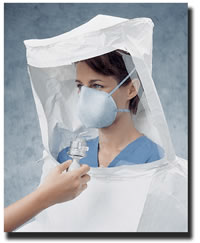
-
- Fit testing a half mask with irritant smoke
- Fit testing a half mask using a Portacount
Step 4.
Training in the hazards that make respirator use necessary as well as how to put on, use, and care for the respirator.
- Provided by EHS
- EHS will issue the employee the appropriate respirator at the time of the initial training.
- Training is repeated annually
- Employees must bring their respirators with them to refresher training
The use of respirators here at Georgia Tech is covered by the Georgia Tech Respiratory Protection Program. Outside of GT, respirators are covered by their own section of Federal law: 29 CFR 1910.134. This is because, while using a respirator properly can prevent chemical exposures, using respirators improperly can actually result in chemical exposures. This is due to what safety professionals call a false sense of security.
Here’s an example of how misuse of a respirator led to a chemical exposure that would not have happened if a respirator was not involved: In 2009 in a Georgia Tech lab, a small bottle of a toxic, anesthetic powder was accidentally knocked off a high shelf (about 5 feet off the ground). The bottle shattered and the powder was strewn about. Some of the powder became aerosolized by the force of the impact. It is also theorized a portion of the material may have sublimed in the bottle and was released as a gas when the bottle shattered. The person in charge of the lab ordered everyone out immediately. She then borrowed a respirator from a neighboring lab group, re-entered the lab, and proceeded to clean up the spill using a dust pan and paper towels. Before she could complete the clean up, she began to feel dizzy. Fortunately, she was able to exit the lab before passing out.
Had the researcher not gained a false sense of security by having the respirator, she would not have re-entered the lab and not suffered the exposure.
The bottom line is that you can’t KNOW that the respirator fits you unless you have been fit tested in it. Wearing a respirator that doesn’t fit or the wrong respirator IS worse than not wearing the respirator at all.
Summary of Rules Regarding Purchase and Use of Respirators
- No one may purchase or use a respirator of any type in Georgia Tech laboratories without prior permission/certification by EHS (this includes N-95 filtering facepieces)
- No one will be given permission to use a respirator unless there has been:
- A Respiratory Hazard Assessment
- Medical Clearance
- Fit Testing
- Training
- GT EHS is the only entity on campus which is authorized to choose respirators or respirator cartridges for GT faculty, staff, and students.
- No one who has been certified to use a respirator for one hazard may use the respirator for another hazard without first consulting with GT EHS.
- Respirators are not to be loaned out or shared between lab users.
- GT Rules do not allow the use of respirators for “comfort measures” without prior approval by EHS.
What Is The Difference Between an N-95 Filtering Facepiece and a Facemask?
Facemasks are loose-fitting, disposable masks that cover the nose and mouth, such as surgical masks and nuisance dust masks. Facemasks are not approved by the National Institute for Occupational Safety and Health (NIOSH) for protection against any regulated hazardous material.
Facemasks help stop droplets from being spread by the person wearing them. They also keep splashes or sprays from reaching the mouth and nose of the person wearing the facemask and are therefore useful when cleaning up spills of infectious materials. They are not designed to protect you against breathing in gases, vapors, or very small particles. Facemasks should be used once and then disposed of.
- Surgical masks
- Nuisance dust mask
N95’s are respirators which are approved by NIOSH for use against certain selected airborne particulates when used as part of a respiratory protection program which includes:
- Respiratory Hazard Evaluation
- Medical Clearance
- Fit Testing
- Training
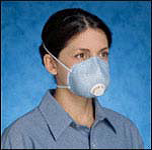
Notice the warning which describes how it may be used below:
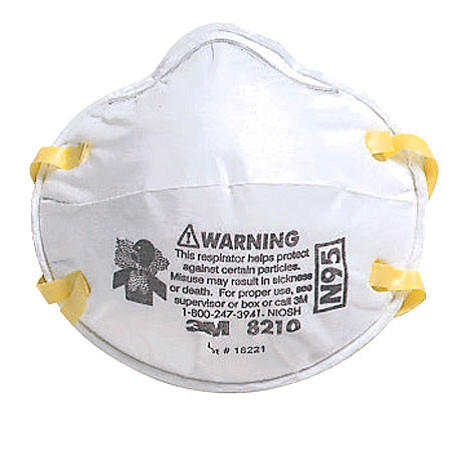
There are nine different classifications of respirator particulate filters based on three different levels of resistance to oily aerosols and filter efficiency:
[collapse title=Class]
N = not resistant to oil
R = resistant (somewhat) to oil
P = oil proof (strongly resistant to oil)
[/collapse]
[collapse title=Efficiency]
95% efficient at stopping particles 0.3 microns (μm) in diameter
97% efficient at stopping particles 0.3 μm
99.97% efficient (but referred to as 100%) at stopping particles 0.3 μm in diameter
[/collapse]
N-95s are approved by NIOSH only for protection against non-oily particulates. A number of N-95s are marketed as “NIOSH Approved” with wording to the effect that they are also for protection against nuisance levels of acids or solvents. These products are NIOSH approved- but only for protection against non-oily particulates. Their use against acid or solvent aerosols is only a manufacturer’s suggestion. N-95s are specifically not approved for use with nano-materials.
Anyone at Georgia Tech who feels he or she may be carrying an infections disease, is encouraged to wear a facemask for the purposes of protecting other people. (Please see the GT Policy on Dealing with H1N1 flu.) Use of facemasks to protect oneself from infections by others has generally been discounted as ineffective.
Use of N-95 respirators as part of a complete Respiratory Protection Program has been approved for protection of specific at risk groups (Public Safety, Student Health) for protection against respiratory infections. Use of N-95 respirators is also permitted by EHS for specific work groups including GT Maintenance, Housing, Landscaping and Building Services. Use of N-95s in a laboratory setting is not allowed without prior permission from GT EHS.
For more information about Respiratory Protection at Georgia Tech, please see the GT Respiratory Protection Program or contact EHS (404-894-4635).
